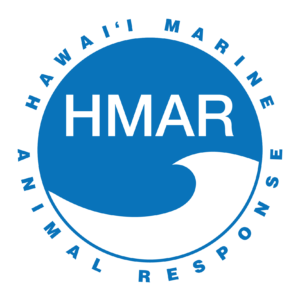HMAR 2022 YEAR IN REVIEW
Hard to believe it’s 2023! 2022 was a busy year for us at HMAR with lots of surprises, challenges and successes! Read on to learn more about our 2022 highlights!
Number of Contacts Made to HMAR Hotlines in 2022 – 9,630 (about 26 each day)
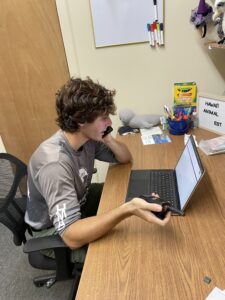 Our hotline operations are one of the most integral parts of the work we do. In 2022, we handled 9,630 contacts (phone calls and texts) that came into our hotlines. Contacts come in from a variety of sources – private citizens, law enforcement agencies, partner conservation organizations, and government departments. Very often, multiple contacts between an observer and a hotline operator are needed to assemble a complete picture of a particular animal situation so keeping track of all of this incoming information is challenging. About 69% of these contacts in 2022 were related to monk seals, 17% were related to sea turtles, 7% were related to seabirds, and about 7% were regarding other things such as marine debris, or protected marine species questions. Without our hotline and dispatch team we wouldn’t know about seals on beaches, turtles in distress or downed seabirds. Although it’s not one of our more visible activities, the team members that work on our Operations Support team enable us to do all of our other work. We wouldn’t be HMAR without the hard work of our hotline operators!
Our hotline operations are one of the most integral parts of the work we do. In 2022, we handled 9,630 contacts (phone calls and texts) that came into our hotlines. Contacts come in from a variety of sources – private citizens, law enforcement agencies, partner conservation organizations, and government departments. Very often, multiple contacts between an observer and a hotline operator are needed to assemble a complete picture of a particular animal situation so keeping track of all of this incoming information is challenging. About 69% of these contacts in 2022 were related to monk seals, 17% were related to sea turtles, 7% were related to seabirds, and about 7% were regarding other things such as marine debris, or protected marine species questions. Without our hotline and dispatch team we wouldn’t know about seals on beaches, turtles in distress or downed seabirds. Although it’s not one of our more visible activities, the team members that work on our Operations Support team enable us to do all of our other work. We wouldn’t be HMAR without the hard work of our hotline operators!
Since our start in 2016, this team has responded to over 55,000 calls and texts to our hotlines involving marine protected animals that may need support. That is incredible work team, keep up the great work!
Number of Field Support Actions in 2022 – 3,205
During 2022, in-field support activity was conducted by HMAR volunteers and staff all over Oʻahu and Molokai 3,205 times. That was broken out as 573 times on the north side of Oʻahu, 919 times in east Oʻahu, 798 times in southeast Oʻahu, 860 times on Oʻahu’s west side, and 55 times on Molokai.
This work is performed by members of our Field Support & Outreach (FSO) team and they are the bread and butter of our organization. Going to beaches with Hawaiian monk seals, identifying and documenting the locations of specific animals, updating photo documentation files on animals, finding possible animal health concerns, and providing public outreach are things we do all over these islands, many times every day. And during Hawaiian monk seal pup season – typically from March to September – our team gets extra busy. And this year was no exception!
We had a total of 9 pups born on Oʻahu or our offshore islets in 2022, unfortunately 3 of those pups did not make it past their first day (born stillborn or died soon after birth) but HMAR was able to recover and transport these animals to NOAA so that post-mortem analyses could be done to determine cause of death, which is vitally important for such an endangered species. But this still left us with 6 live pups to monitor and support during the year – half of which we weren’t expecting!
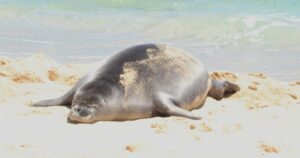
 Our first surprise of the 2022 pup season was when RH92 gave birth to her first pup ever, RQ64 “Laki” (meaning lucky). (see picture left) This mother seal, RH92, was born on Kauaʻi, so we had anticipated her to give birth there instead of on Oʻahu, especially since she gave birth on a beach on Oʻahu we don’t have any record of her visiting previously! Then, one day later came RQ24, “Makaʻuʻole” (meaning fearless), born on the North Shore to mom, RN58, “Luana.” (see picture right)
Our first surprise of the 2022 pup season was when RH92 gave birth to her first pup ever, RQ64 “Laki” (meaning lucky). (see picture left) This mother seal, RH92, was born on Kauaʻi, so we had anticipated her to give birth there instead of on Oʻahu, especially since she gave birth on a beach on Oʻahu we don’t have any record of her visiting previously! Then, one day later came RQ24, “Makaʻuʻole” (meaning fearless), born on the North Shore to mom, RN58, “Luana.” (see picture right)
Soon enough, RQ76 “Malama” (light, moon, or month) and PO7 (no permanent ID) “Mahina” (moon) were then both born one day apart on an Oʻahu offshore islet!
 RQ58, “Koalani” (meaning heavenly warrior) was our second surprise of pup season! (see picture left) When RH58 “Rocky” showed up on Kaimana beach in Waikīkī and gave birth for the second time on Oʻahu our team immediately sprang into action. Over the next 6 weeks we spent 14 hours each day on Kaimana Beach, watching to make sure little Koalani stayed healthy and safe with mom. Kaimana Beach pups are always incredibly challenging due to the high volume of beach goers, but they are also one of our most rewarding outreach opportunities!
RQ58, “Koalani” (meaning heavenly warrior) was our second surprise of pup season! (see picture left) When RH58 “Rocky” showed up on Kaimana beach in Waikīkī and gave birth for the second time on Oʻahu our team immediately sprang into action. Over the next 6 weeks we spent 14 hours each day on Kaimana Beach, watching to make sure little Koalani stayed healthy and safe with mom. Kaimana Beach pups are always incredibly challenging due to the high volume of beach goers, but they are also one of our most rewarding outreach opportunities!
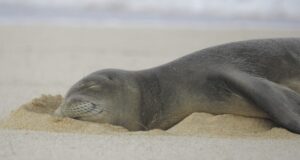 And last but not least, RQ72 “Lehiwa” (which means admirable and attractive) was our third surprise of pup season! R016 “Right Spot” typically gives birth on Molokai, but instead, she decided to give birth at one of her favorite spots on Oʻahu! (see picture right)
And last but not least, RQ72 “Lehiwa” (which means admirable and attractive) was our third surprise of pup season! R016 “Right Spot” typically gives birth on Molokai, but instead, she decided to give birth at one of her favorite spots on Oʻahu! (see picture right)
If you’re missing those cute little faces, don’t worry! Pup season will be back before we know it!
Besides pup season and daily field response and outreach work, the FSO team also worked on a few other major events and projects in 2022.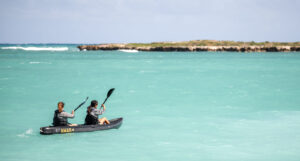 From April to
From April to October last year we systematically surveyed 4 offshore islands around Oʻahu for sea turtle nests in a project coordinated with the U.S. Fish & Wildlife Service Pacific Islands Coastal Program. This is the first time this research has been conducted and the project consisted of our interns and staff going out on our “Rescue 3” kayaks or our “Rescue 1” RIB boat 51 times (see pictures left) to look for sea turtle tracks and nests. This is important to determine if, and how, sea turtles may be using these offshore islets as nesting habitat since green sea turtle nesting on Oʻahu has been on the increase. In total, we spent 104 hours on the water in 2022 surveying for nests on these remote islets. We will be continuing the project again in 2023 and we’re excited to develop this program!
October last year we systematically surveyed 4 offshore islands around Oʻahu for sea turtle nests in a project coordinated with the U.S. Fish & Wildlife Service Pacific Islands Coastal Program. This is the first time this research has been conducted and the project consisted of our interns and staff going out on our “Rescue 3” kayaks or our “Rescue 1” RIB boat 51 times (see pictures left) to look for sea turtle tracks and nests. This is important to determine if, and how, sea turtles may be using these offshore islets as nesting habitat since green sea turtle nesting on Oʻahu has been on the increase. In total, we spent 104 hours on the water in 2022 surveying for nests on these remote islets. We will be continuing the project again in 2023 and we’re excited to develop this program!

The FSO team also continued its work in 2022 to maintain and support important seabird nesting habitat, perform public field outreach at seabird colonies, and conducting seabird population surveys in collaboration with the University of Hawaiʻi and Hawaiʻi Pacific University. Through this work we were able to report that at one HMAR-managed colony, we saw a 150% year-over-year increase in wedge tailed shearwaters that were nesting at the location! (see picture right)
Since our start in 2016, HMAR has deployed volunteers and staff into the field in support of marine protected species over 24,000 times. Outstanding job FSO team!
Number of Rescues, Interventions, Stranding Responses and Escalated Field Actions Conducted in 2022 – 435
In 2022, this number included 41 operations for marine mammals, 185 operations for sea turtles, and 209 operations for seabirds. This brings our total rescues, interventions, stranding responses, and escalated field actions since our start in 2016 to about 2,100 operations.
Every year has a number of notable rescues, interventions, stranding responses, and escalated field actions, and 2022 was no exception. Here are some highlights of rescues and interventions that stood out in 2022.
We started the year off in the first few days of January 2022 when a call came in for a stranded 18 foot sperm whale in ʻĀina Haina. Our team responded and along with partners from UH and NOAA we found that the whale was in fact deceased, but it was not a sperm whale. Instead, it was a humpback whale calf. After planning and preparations were made, the team was able to carefully and safely remove the calf from the shallow waters to transport it for a post-mortem cause of death analysis. It was later found that the calf had been hit by a vessel of some type and had passed away from its injuries. This incident was an important reminder that assigning a spotter at the front of any vessel and moderating your speed in channels are important ways to help maintain the safety of our marine wildlife.
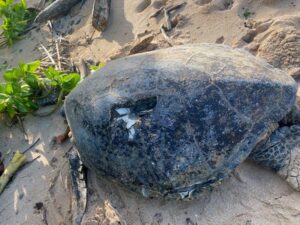 Also in January, we rescued a female green sea turtle (honu) at Laniakea with a large wound on the top of her shell (carapace) from a boat strike. (see picture left) She had an 8” long, 4” wide hole in her carapace. But she was still incredibly active and broke our transport carrier trying to escape! She was then moved to a partner facility on Maui for further care. Since then, “Aloha” as she is called, has continued to improve and we are hopeful for a full recovery and release soon.
Also in January, we rescued a female green sea turtle (honu) at Laniakea with a large wound on the top of her shell (carapace) from a boat strike. (see picture left) She had an 8” long, 4” wide hole in her carapace. But she was still incredibly active and broke our transport carrier trying to escape! She was then moved to a partner facility on Maui for further care. Since then, “Aloha” as she is called, has continued to improve and we are hopeful for a full recovery and release soon.
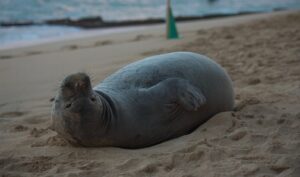 In June we said goodbye to one of Oʻahu’s most famous seals – RE74 “Benny” (see picture right). At 20 years old, Benny was found deceased on the North Shore where HMAR responded for the recovery. Benny was a staple of the Oʻahu Hawaiian monk seal community and was well known by our staff, volunteers and the public for his ability to stir up a little bit of trouble every once in a while! Benny will surely be missed, but his passing is a reminder to us all that we must continue the important work that we, our partners, and our engaged public do everyday to support the survival, preservation, and recovery of this iconic and beloved species.
In June we said goodbye to one of Oʻahu’s most famous seals – RE74 “Benny” (see picture right). At 20 years old, Benny was found deceased on the North Shore where HMAR responded for the recovery. Benny was a staple of the Oʻahu Hawaiian monk seal community and was well known by our staff, volunteers and the public for his ability to stir up a little bit of trouble every once in a while! Benny will surely be missed, but his passing is a reminder to us all that we must continue the important work that we, our partners, and our engaged public do everyday to support the survival, preservation, and recovery of this iconic and beloved species.
 July was a busy month for seal escalations! At the beginning of the month we got reports that RQ64 “Laki,” a young recently-weaned pup was entangled around her neck with rope (see picture left). Our team, along with our partners at NOAA, immediately made a game plan to survey for Laki until she was found to attempt a disentanglement. After days of search activity, we were lucky enough to find her near the original sighting location. NOAA and HMAR staff immediately set their plan in motion and arrived on site to remove the entanglement. Thankfully, the capture and removal of the rope from around Laki’s neck was successful! Since then we’ve seen her several times and she is behaving like a normal young seal.
July was a busy month for seal escalations! At the beginning of the month we got reports that RQ64 “Laki,” a young recently-weaned pup was entangled around her neck with rope (see picture left). Our team, along with our partners at NOAA, immediately made a game plan to survey for Laki until she was found to attempt a disentanglement. After days of search activity, we were lucky enough to find her near the original sighting location. NOAA and HMAR staff immediately set their plan in motion and arrived on site to remove the entanglement. Thankfully, the capture and removal of the rope from around Laki’s neck was successful! Since then we’ve seen her several times and she is behaving like a normal young seal.
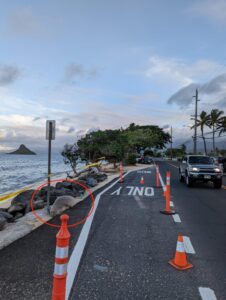 Then, on the afternoon of July 4th, we responded to RK28 “KC” who had hauled out onto the side of the road at a bus stop near Kualoa Ranch (see picture right). With help from HPD who restricted traffic, the HMAR team was able to safely get KC off the side of the road and back into the water. A few weeks later KC returned to Kauaʻi to give birth to her pup!
Then, on the afternoon of July 4th, we responded to RK28 “KC” who had hauled out onto the side of the road at a bus stop near Kualoa Ranch (see picture right). With help from HPD who restricted traffic, the HMAR team was able to safely get KC off the side of the road and back into the water. A few weeks later KC returned to Kauaʻi to give birth to her pup!
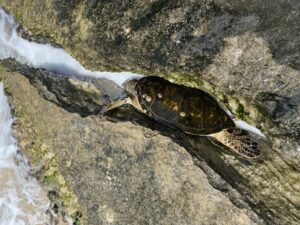 In September we also had a memorable sea turtle rescue when an adult female green sea turtle was reported wedged in the rocks and unable to free herself on the North Shore. In difficult conditions, which included waves washing over the rocks, and rising seas that could drown the sea turtle (see picture left), our HMAR team was able to carefully extract this beauty without injury, assess her condition, and release her back to her ocean home. Thanks go out to two members of the public who were nearby and willing to assist in this rescue.
In September we also had a memorable sea turtle rescue when an adult female green sea turtle was reported wedged in the rocks and unable to free herself on the North Shore. In difficult conditions, which included waves washing over the rocks, and rising seas that could drown the sea turtle (see picture left), our HMAR team was able to carefully extract this beauty without injury, assess her condition, and release her back to her ocean home. Thanks go out to two members of the public who were nearby and willing to assist in this rescue.
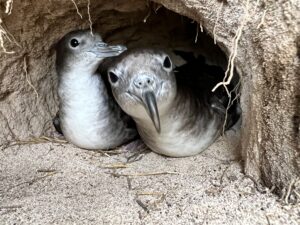 And of course, during the last quarter of 2022 we had seabird fallout season! This is a period of time when our young wedge tailed shearwaters (ʻuaʻu kani) leave their burrows. They nest underground (see picture right) so they are very vulnerable to invasive predators (i.e. cats and mongoose), sea level rise, and off-trail hikers. This time of year, the young fledglings leave their burrows to take to the skies at night for the first time and sometimes become distracted by artificial light. This confuses these young birds and instead of flying out to sea guided by moonlight, they instead fly towards artificial sources of light on land, ultimately become exhausted, and are forced to the ground (“fall out”). In 2022 we rescued 209 seabirds, many of which were during fallout season, a time of year that keeps us running around the island rescuing as many as 10 birds in a single day!
And of course, during the last quarter of 2022 we had seabird fallout season! This is a period of time when our young wedge tailed shearwaters (ʻuaʻu kani) leave their burrows. They nest underground (see picture right) so they are very vulnerable to invasive predators (i.e. cats and mongoose), sea level rise, and off-trail hikers. This time of year, the young fledglings leave their burrows to take to the skies at night for the first time and sometimes become distracted by artificial light. This confuses these young birds and instead of flying out to sea guided by moonlight, they instead fly towards artificial sources of light on land, ultimately become exhausted, and are forced to the ground (“fall out”). In 2022 we rescued 209 seabirds, many of which were during fallout season, a time of year that keeps us running around the island rescuing as many as 10 birds in a single day!
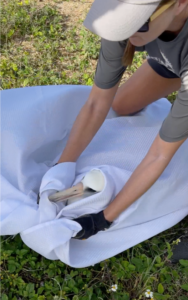 Then, on the last day of the year, we were called to rescue a Laysan albatross (mōlī) on the North shore that had an injury to one of its legs and was having great difficulty walking (see picture left). Seabirds the size of an albatross can be quite challenging but two HMAR team members were able to safely and carefully collect the animal and bring it in for a veterinary evaluation provided by our partners at Feather & Fur Animal Hospital.
Then, on the last day of the year, we were called to rescue a Laysan albatross (mōlī) on the North shore that had an injury to one of its legs and was having great difficulty walking (see picture left). Seabirds the size of an albatross can be quite challenging but two HMAR team members were able to safely and carefully collect the animal and bring it in for a veterinary evaluation provided by our partners at Feather & Fur Animal Hospital.
Of course, there were hundreds of other responses in 2022 that we can’t list here. From supporting interventions for monk seals, to sea turtles needing help, and rescuing injured seabirds, we respond to conduct rescues, interventions, stranding responses, and escalated field actions almost every day. These operations require specialized training that our staff, interns and rescue volunteers go through to ensure the safety and health of the animals we are supporting as well as the safety of our team. Please remember that handling a marine protected animal in distress, without proper training, experience, or having the necessary and required government permits, is dangerous for you and can cause further animal injuries or complications. Instead, please call the NOAA Marine Wildlife Hotline at 888-256-9840 so that we can respond.
Marine Debris Removal – 2022 Successes!
Our Marine Debris Program (MDP) team worked incredibly hard underwater in 2022 removing fishing debris that can injure and kill our iconic marine protected species! (see picture right) Here are some of the most exciting numbers and successes from 2022.

- Number of HMAR-lead marine debris removal dives conducted: 52
- Number of HMAR Beat Debris project citizen science dives conducted: 125
- Feet of monofilament line removed: 52,656 (thatʻs 10 MILES!)
- Number of hooks removed: 1,520
- Number of animal hazards removed: 1,491
- Acres of underwater habitat cleaned: 78
Since starting our Marine Debris Program in 2019, HMAR team members have now conducted 162 underwater dive operations while our citizen science Beat Debris project participants have conducted an additional 337 underwater dives. Collectively, we’ve removed about 198,000 feet (thatʻs about 38 MILES!) of monofilament line and 4,600 hooks, and cleared out over 4,100 underwater animal hazards before these items can kill or injure our wildlife. This has resulted in the cleaning of 263 acres of underwater habitat. Great job HMAR team divers! Great job Beat Debris citizen science divers! Keep up the great work team!
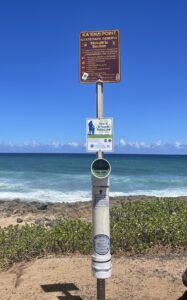 In other HMAR MDP activity, in 2022 we got approval to install an additional 6 new fishing debris bins around Oʻahu! One along the Kaiwi shoreline, two at Sand Island and three at Kaʻena Point State Park! This brings our total of bins deployed to 15 and we have many more planned. If youʻve never seen these bins before, let us explain! Around the island at popular fishing spots we have set up these bins (see picture left) for fishers to deposit their discarded line and hooks. Because of these bins, hooks, line, and weights donʻt end up left on the pier or shoreline to find its way back into the ocean where it can injure or kill wildlife. Plus, we take the line and it is recycled to turn it into baby fish habitat. These bins prevent hooking or entanglement hazards from entering the nearshore ocean environment in the first place. Good job fishers! Keep up the good work of stuffing these bins with fishing line, hooks, and weights.
In other HMAR MDP activity, in 2022 we got approval to install an additional 6 new fishing debris bins around Oʻahu! One along the Kaiwi shoreline, two at Sand Island and three at Kaʻena Point State Park! This brings our total of bins deployed to 15 and we have many more planned. If youʻve never seen these bins before, let us explain! Around the island at popular fishing spots we have set up these bins (see picture left) for fishers to deposit their discarded line and hooks. Because of these bins, hooks, line, and weights donʻt end up left on the pier or shoreline to find its way back into the ocean where it can injure or kill wildlife. Plus, we take the line and it is recycled to turn it into baby fish habitat. These bins prevent hooking or entanglement hazards from entering the nearshore ocean environment in the first place. Good job fishers! Keep up the good work of stuffing these bins with fishing line, hooks, and weights.
We’re proud of the work our MDP team and our engaged citizen science divers do and we look forward to more great results in 2023!
Number of People Reached Through Face to Face Outreach and Education in 2022 – 39,705
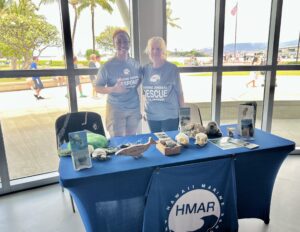 2022 was a record breaking year for our Education & Engagement (EE) department. With COVID cases finally on a steady decline we were able to go to classes and public outreach events in person for the first time in two years. Compared to 2021 we more than doubled our number of events and people reached in 2022! In total we did 133 presentations and reached 8,665 people in 2022 – educating about Hawaiian monk seals, sea turtles, marine debris and more.
2022 was a record breaking year for our Education & Engagement (EE) department. With COVID cases finally on a steady decline we were able to go to classes and public outreach events in person for the first time in two years. Compared to 2021 we more than doubled our number of events and people reached in 2022! In total we did 133 presentations and reached 8,665 people in 2022 – educating about Hawaiian monk seals, sea turtles, marine debris and more. 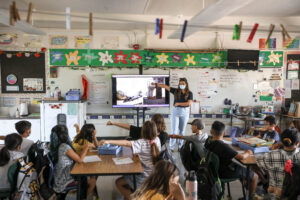 In 2022 we also stepped up our efforts to provide education in underserved and underrepresented communities around the island and 63% of the presentations we provided were in underserved areas!
In 2022 we also stepped up our efforts to provide education in underserved and underrepresented communities around the island and 63% of the presentations we provided were in underserved areas! 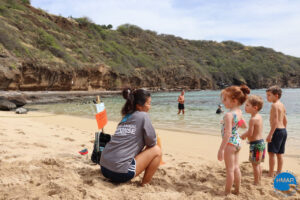 Meanwhile, during 2022 while our EE team was doing their great work in schools, community events and other presentations, our busy FSO team in the field also continued their excellent job of performing public outreach while conducting marine protected species support activity, reaching an additional 30,000+ people.
Meanwhile, during 2022 while our EE team was doing their great work in schools, community events and other presentations, our busy FSO team in the field also continued their excellent job of performing public outreach while conducting marine protected species support activity, reaching an additional 30,000+ people.
Reaching residents and visitors through outreach and education is a key part of what we do and since our start in 2016, we’ve now reached over 305,000 people! This work is vital so that we can inform, build support, and affect change for marine protected animals and the ocean.
Additional News & Updates
Before we sign off for 2022, our staff members want to acknowledge some really important key people or groups that help HMAR do what we do. We are incredibly grateful to each and every one of you, and here are some special shout outs!
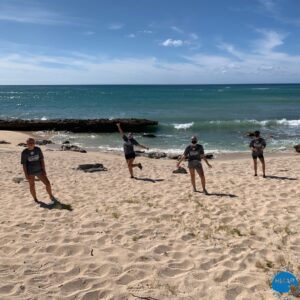 Emily Greene (Education & Engagement Manager) – I’m so grateful for all of our interns who support our work each and every day. Managing our internship program this year has taught me a lot and I’m so thankful that I get to watch our students grow and learn as they move through their internships. They put in so many long hours and really do go above and beyond – we couldn’t do what we do without them!
Emily Greene (Education & Engagement Manager) – I’m so grateful for all of our interns who support our work each and every day. Managing our internship program this year has taught me a lot and I’m so thankful that I get to watch our students grow and learn as they move through their internships. They put in so many long hours and really do go above and beyond – we couldn’t do what we do without them!
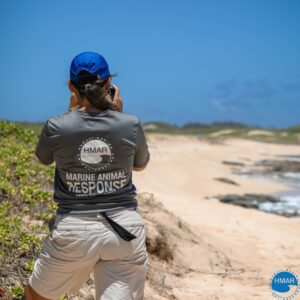 McKinley Walter (Oʻahu Field Support Manager) and Evelyn Macias (Oʻahu Field Support Technician) – Thank you to our volunteers. These dedicated people put in thousands of hours each year to support our mission here at HMAR. We would not be able to do the work that we do without all of their hard work, dedication and passion. A huge thank you to all of our volunteers from the HMAR staff!
McKinley Walter (Oʻahu Field Support Manager) and Evelyn Macias (Oʻahu Field Support Technician) – Thank you to our volunteers. These dedicated people put in thousands of hours each year to support our mission here at HMAR. We would not be able to do the work that we do without all of their hard work, dedication and passion. A huge thank you to all of our volunteers from the HMAR staff!
Michael Tillman (Operations Support Manager) – Thank you to the federal, state, and county agencies we partner with, as well as the many commercial businesses and land owners that have helped our efforts in conservation for Hawaiʻi’s marine protected species during 2022!
Anabel Cepero (Marine Programs Technician) – I want to thank Kekai Mar from the Hawaii DLNR Division of State Parks, for his support this past year. With Kekai’s assistance, weʻre installing six additional fishing debris bins across the island. The installation of these much-needed bins creates a collection point for any leftover fishing gear and line, which could end up in the ocean and become a potential hazard to marine life. He went above and beyond to help us through the permit process and invited our team to community events that allowed us to share more about HMAR, our programs, and to get people involved.
Todd Yamashita (Molokai Community Programs Manager) – The Molokai community is a lot like a family… We look out for each other and help care for the things we love. Big mahalo island-wide to everyone helping to look after our Molokai monk seals!
Jon Gelman (Founder & President of HMAR) – I am thankful for our individual private contributors, people like you, who donate hard-earned dollars to help us. Grants and corporate sponsors are incredibly important to back our activity but these funders only cover a portion of our costs. Therefore, private individuals who make the sacrifice to donate make a huge difference for us! We are so appreciative of your generosity and in awe that you go out of your way to support us from near and far.
As always, we can’t do the work we do without all of you! We rely heavily on donations to pay for gas, supplies, insurance, rent, truck maintenance, and all the other things we need to do our work. Marine animal response, rescue, and education is very rewarding but not inexpensive. If you want to support us, please donate or consider volunteering HERE, and every dollar helps. Mahalo for your support during 2022. Check back with us for monthly updates during 2023!
